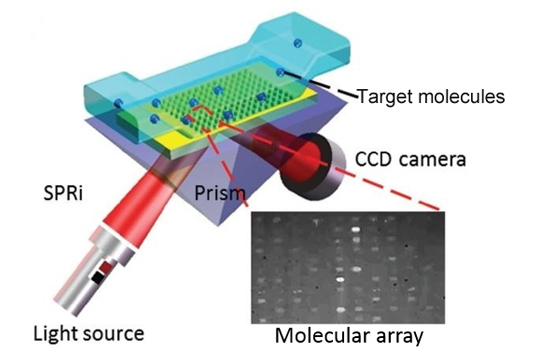Surface Plasmon Resonance imaging (SPRi), namely surface plasmon resonance microscopy (SPRM), is a real-time, label-free, and high-throughput technique which is used to study biomolecular interactions based on detecting the refractive index changes resulting from molecular binding. More specifically, SPRi has been developed to examine affinity between biomoleculars, screen biomarkers and detect biopsy specimens.

Basic principles:
Surface Plasmon Resonance (SPR) is an optical detection process that occurs when a polarized light hits a prism covered by a thin planar metal (typically gold or silver) layer. At certain angles of incidence, a portion of the light energy couples through the gold coating and creates a surface plasmon wave at the sample and gold surface interface. The angle of incident light required to sustain the surface plasmon wave is very sensitive to changes in refractive index at the surface (due to mass change), and it is these changes that are used to monitor the association and dissociation of biomolecules.
Applications:
Kinetic characterization by Surface Plasmon Resonance and other methods has already been an important step for drug researchers to select and characterize novel therapeutics as well as for basic life scientists to investigate specific biological binding events. When combined with appropriate surface chemistry, microfluidics and software, SPRi is unmatched in its range of applications including:
- Affinity analysis
- Kinetic analysis
- Ligand-fishing
- Epitope mapping
- Protein / protein interaction
- DNA/DNA interactions
- Protein/carbohydrates
- Protein / DNA interactions
- RNA/RNA interactions
- Antibody (protein) / bacteria interactions
- Antibody / cell interactions
- Peptide / protein interactions
- Polymer / polymer interactions
















